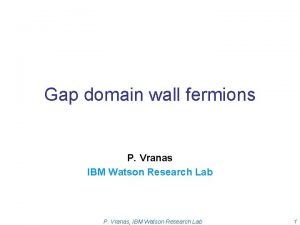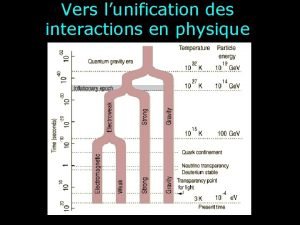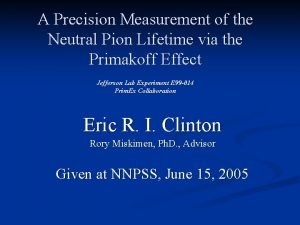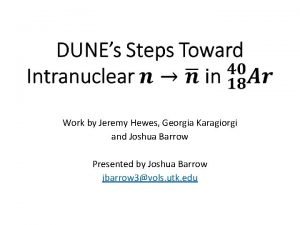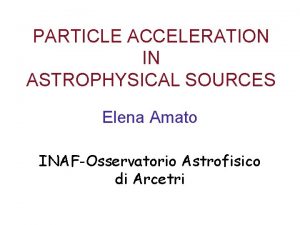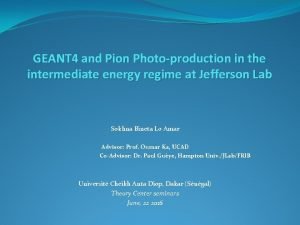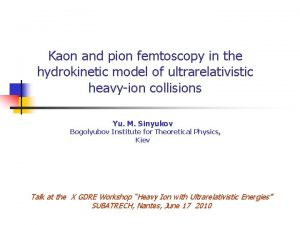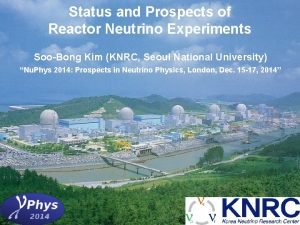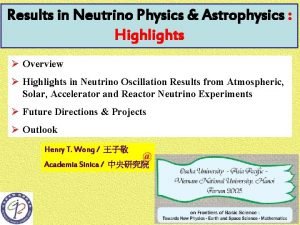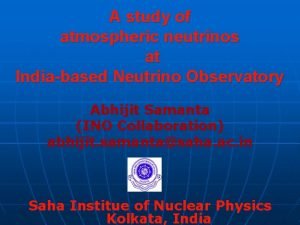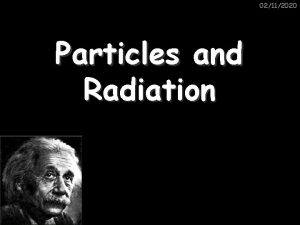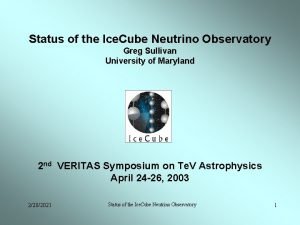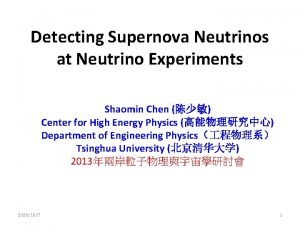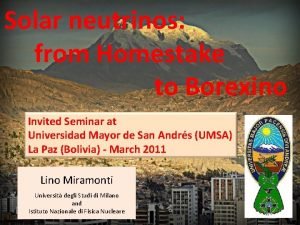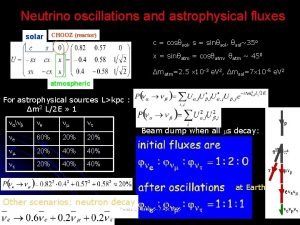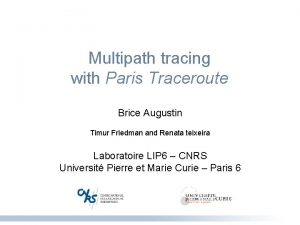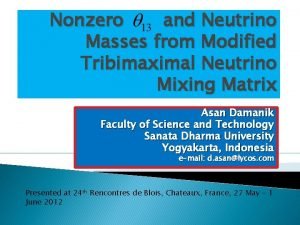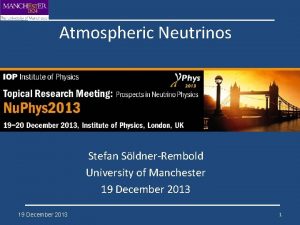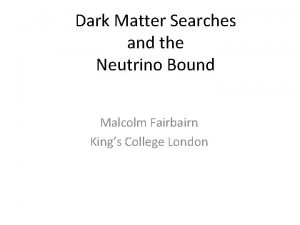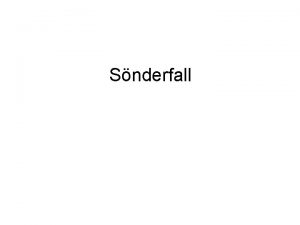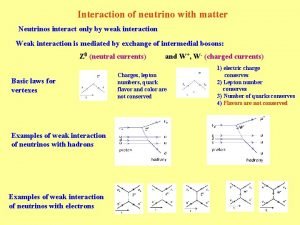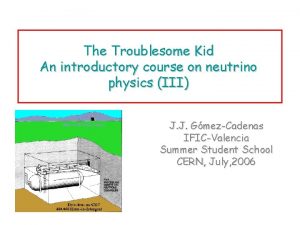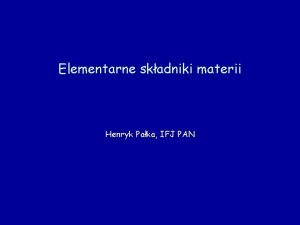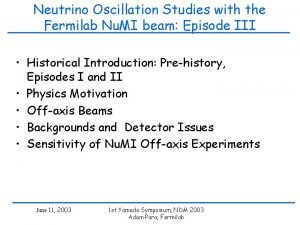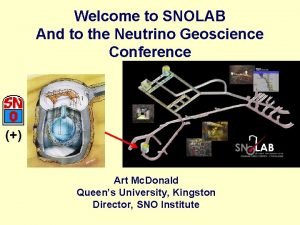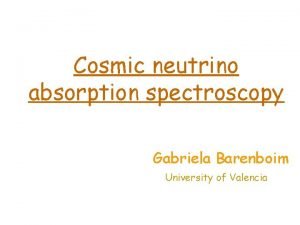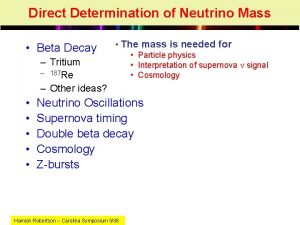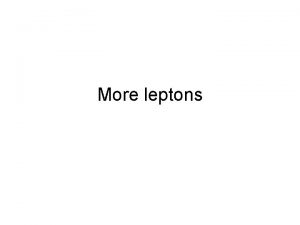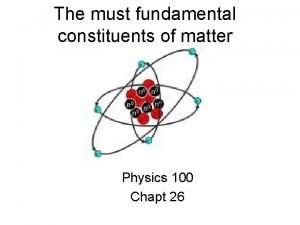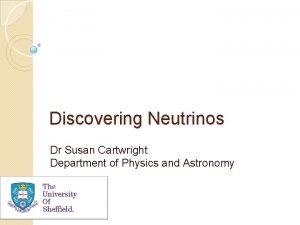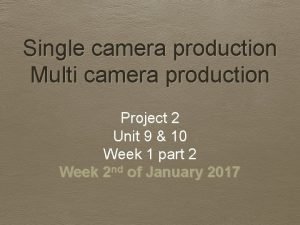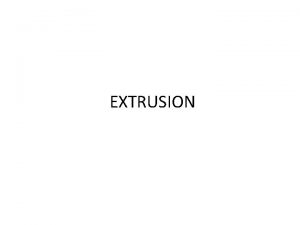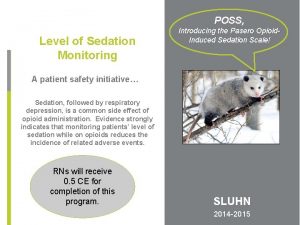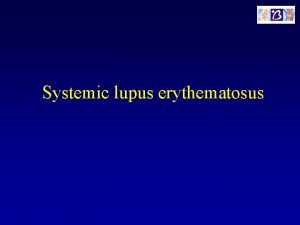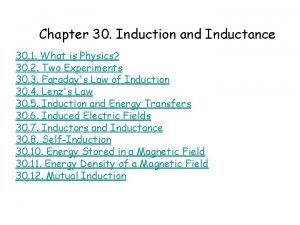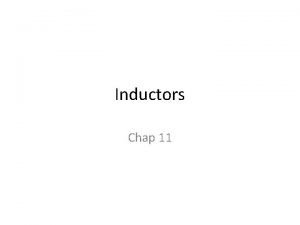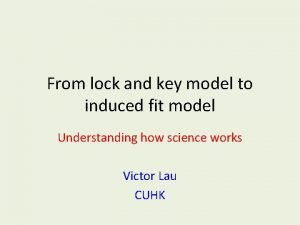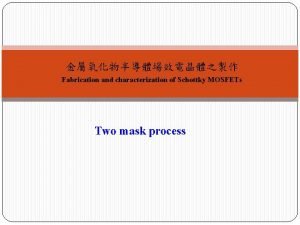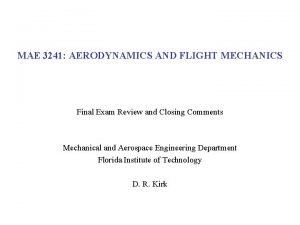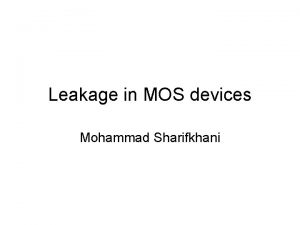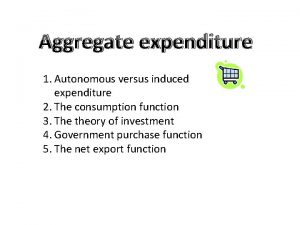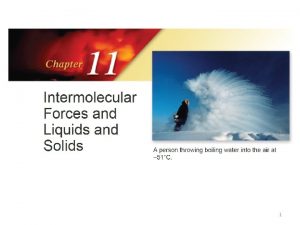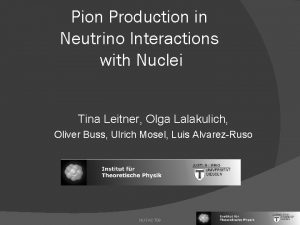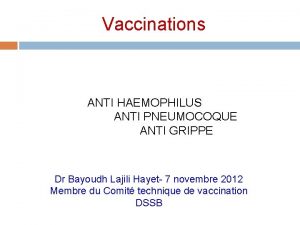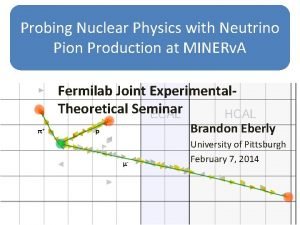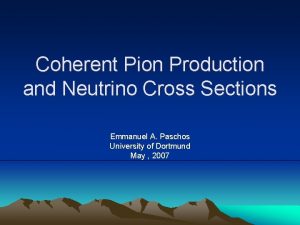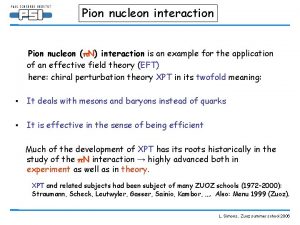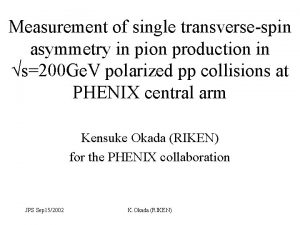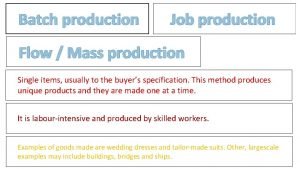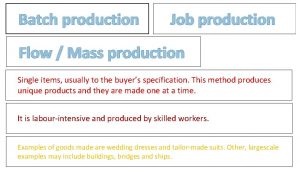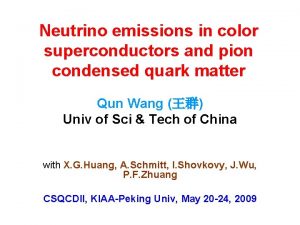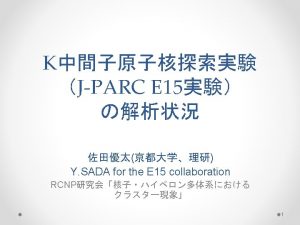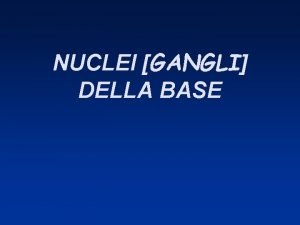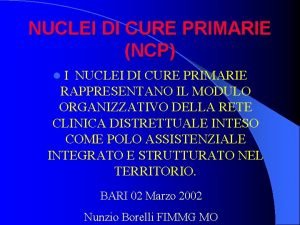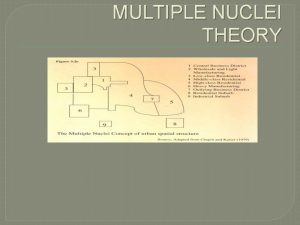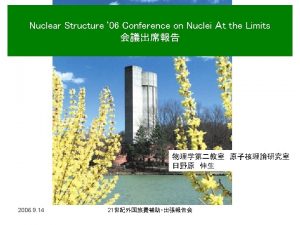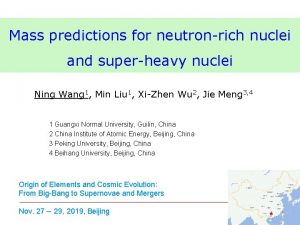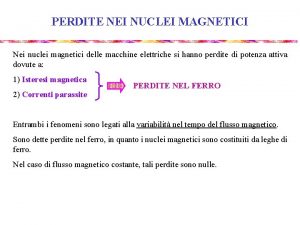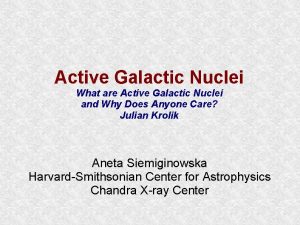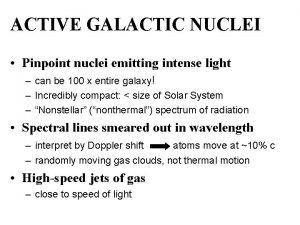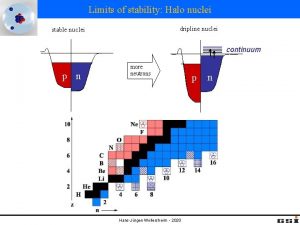Anti Neutrino Induced Single Pion Production From Nuclei




![q Resonance Processes üRein and Sehgal model is used [Ann. Phys. 133, 79 (1981)]. q Resonance Processes üRein and Sehgal model is used [Ann. Phys. 133, 79 (1981)].](https://slidetodoc.com/presentation_image/7df1661d25256dfa45f34019ef08cd01/image-5.jpg)
















































- Slides: 53

(Anti) Neutrino Induced Single Pion Production From Nuclei S. K. Singh Department of Physics Aligarh Muslim

Single Pion Production through Excitation of Baryon Resonances and their subsequent decays Incoherent Pion Production Coherent Pion Production

Energy Region Of Interest E 3 Ge. V At: K 2 K Mini. Boo. NE -beam Atmospheric MINER A

Neutrino Event Generators NUANCE, NEUGEN, NEUT, NUX, GENEVE, FLUKA etc. All the neutrino event generators use some Nuclear Model to estimate but inclusion of nuclear effects is mainly limited to Quasielastic reactions Common theoretical inputs to all neutrino event generators Ø Llewellyn Smith free nucleon Q. E. X-section Phys. Rep. 3 C, 261 (1972). Ø Rein and Sehgal Resonance X-section Ann. Phys. 133, 79 (1981). Ø Standard DIS formula for high Q 2 Inputs which are different for various neutrino event generators Ø Treatment of Nuclear Effects Ø Joining of resonance and DIS Ø Treatment of DIS
![q Resonance Processes üRein and Sehgal model is used Ann Phys 133 79 1981 q Resonance Processes üRein and Sehgal model is used [Ann. Phys. 133, 79 (1981)].](https://slidetodoc.com/presentation_image/7df1661d25256dfa45f34019ef08cd01/image-5.jpg)
q Resonance Processes üRein and Sehgal model is used [Ann. Phys. 133, 79 (1981)]. üTreatment of Nuclear medium effects is not complete An ad hoc suppression of pion production: ü 20% for I 3 = ± 1/2 Resonance excitations ü 10% for I 3 = ± 3/2 Resonance excitations D. Casper, NPB(PS) 112, 161 (2002) q Coherent Process üRein and Sehgal model is used [Ann. Phys. 133, 79 (1981)]. q Deep Inelastic Scattering üParton Distribution function of Albright and Jarlskog üNuclear medium Effects (by Bodek and Yang)

Weak Pion Production From Nucleons In the intermediate energy region of about 1 Ge. V the pion production process from nucleons is dominated by excitation of - resonance. Charged Current Single Pion production On Free Nucleon Neutral Current Single Pion production On Free Nucleon

In the model of dominance the neutrino induced Charged Current one pion production is calculated using the basic Weak interaction Lagrangian Weak Charged current coupled to W field Leptonic Weak Current Hadronic Weak Current

The Matrix Element For Production Weak Vector N- Transition From Factors Weak Axial Vector N- Transition From Factors

N- Transition Form Factors Vector Form Factors They are generally parameterized in Dipole form: For i = 3, 4, 5 However, some authors have recently proposed modified Dipole Form factors. For example, Lalakulich et al. , PRD 74, 014009 (2006): For i = 3, 4 For i = 5 Paschos et al. , PRD 69, 014013 (2004) and Leitner et al. , PRC 73, 065502 (2006) use:

Axial Vector Form Factors The Axial Vector form factors are generally parameterized in a Modified Dipole form and are given as: Schreiner and F. von Hippel NPB 58, 333 (1973) and Singh et al. PLB 416, 23 (1998) a 3= b 3 = 0 , a 4 = a 5 = -1. 21, b 4 = b 5 = 2 Ge. V 2 i = 3, 4, 5 Lalakulich et al. , PRD 74, 014009 (2006) Paschos et al. , PRD 69, 014013 (2004) Leitner et al. , PRC 73, 065502 (2006) i = 3, 4, 5 References C 3 V(0) C 4 V(0) C 5 V(0) C 3 A(0) C 4 A(0) C 5 A(0) MV(Ge. V) MA(Ge. V) Schreiner and F. von Hippel 2. 05 -M/M 0. 0 -0. 30 1. 2 0. 73 1. 05 Singh et al. 2. 05 -M/M 0. 0 -0. 30 1. 2 0. 73 1. 05 Paschos et al. 1. 95 -M/W 0. 0 -0. 25 1. 2 0. 84 1. 05 Lalakulich et al. 2. 13 -1. 51 0. 48 0. 0 -0. 25 1. 2 0. 84 1. 05 Leitner et al. 1. 95 -M/W 0. 0 -0. 25 1. 2 0. 84 1. 05

The differential scattering cross section is given by with and Where is the weak N- transition vertex, and is the Rarita Schwinger spin-3/2 projection operator given as (W) is decay width taken to be energy dependent P-wave decay Width given as: Pion momentum in the rest frame of resonance

Weak Production of Pion From Nuclei 1. Incoherent Weak Production of Pion 2. Coherent Weak Production of Pion Incoherent Weak Production of Pion In the nucleus the neutrino interacts with a nucleon moving inside the nucleus of density with its corresponding momentum constrained to be below its Fermi momentum The differential cross section for production in local density approximation is written as

Nuclear Effects q The nuclear medium effects in production are important. q In the nuclear medium the M and are modified q These are mainly due to following processes üIn the nuclear medium N , The final nucleons have to be above the Fermi momentum of the nucleon in the nucleus, thus inhibiting the decay Pauli Correction factor k. F is the Fermi momentum and k is the momentum

ü Additional decay channels: o N NN, NNN (Two and three body absorption process through which disappears in the nuclear medium without producing pions o N NN (Two body absorption process gives rise to more pions) with The imaginary part of the delta self energy is parameterized as CQ ~ accounts for the N N N process CA 2~ accounts for two-body absorption process N N N CA 3~ accounts for three-body absorption process N N N N

The Coefficients CQ , CA 2 , CA 3 , , and (=2 ) are parameterized in the range 80 < T < 320 Me. V ( where T is the pion kinetic energy ) as Coefficient CQ(Me. V s ) -5. 19 a 15. 35 b 2. 06 c CA 2(Me. V) CA 3(Me. V) 1. 06 -6. 64 22. 66 -13. 46 46. 17 -20. 34 =2 0. 382 -0. 038 -1. 322 0. 204 1. 466 0. 613

The Differential Scattering Cross Section Modifies to For Charged Current Incoherent one + production from proton target For Charged Current Incoherent one + production from nuclear target As ++ p + + and + p + 0 (n + +)

Final State Interactions (FSI) FSI for Incoherent Pion Production The pions which are produced in these processes while traveling inside the nucleus can be absorbed, can change direction, energy, charge, or even produce more pions due to elastic and charge exchange scattering with the nucleons present in the nucleus through strong interactions. The effect of final state interaction (FSI) on the weak production cross section for pions are estimated with the help of a Monte Carlo simulation for propagation of pions in the nuclear medium using as the basic input the probabilities per unit length for each of these channels to happens. We have used the Monte Carlo simulation code provided by the M. J. Vicente Vacas for final state interaction of pions.

Results For Neutrino Induced Incoherent Process

Charged Current Incoherent Pion Production Phys. Rev. D 74, 073008 (2006)

Charged Current Incoherent Pion Production (with NME and without FSI) / (Free cross section) (with NME and FSI) / (Free cross section) NME: Nuclear Medium Effects, FSI: Final State Interaction

Charged Current Incoherent Pion Production Form Factor Dependence Lalakulich et al. PRD 74, 014009 (2006). Paschos et al. PRD 69, 014013 (2004) Schreiner and F. von Hippel, NPB 58, 333 (1973)

Charged Current Incoherent Lepton Production averaged over Mini. Boo. NE neutrino spectrum

Charged Current Incoherent Lepton Production Form Factor Dependence Lalakulich et al. PRD 74, 014009 (2006). Paschos et al. PRD 69, 014013 (2004). Schreiner and F. von Hippel, NPB 58, 333 (1973).

Charged Current Incoherent Lepton Production averaged over K 2 K neutrino spectrum

Charged Current Incoherent Lepton Production averaged over Mini. Boo. NE neutrino spectrum 12 C Lalakulich et al. PRD 74, 014009 (2006). Paschos et al. PRD 69, 014013 (2004). Schreiner and F. von Hippel, NPB 58, 333 (1973). Phys. Rev. D 74, 073008 (2006)

Charged Current Incoherent Lepton Production averaged over K 2 K neutrino spectrum 16 O Lalakulich et al. PRD 74, 014009 (2006). Paschos et al. PRD 69, 014013 (2004). Schreiner and F. von Hippel, NPB 58, 333 (1973). Phys. Rev. D 74, 073008 (2006)

Comparison With Experiments

Phys. Rev. D 74, 073008 (2006)

Lalakulich et al. PRD 74, 014009 (2006). Paschos et al. PRD 69, 014013 (2004). Schreiner and F. von Hippel, NPB 58, 333 (1973). Phys. Rev. D 74, 073008 (2006)

The dashed (solid) stairs are the Cross sections from NEUGEN(NUANCE) MC generators. Experimental points Are the Mini. Boo. NE results. The theoretical curves show the CC 1 + cross section using Lalakulich et al. N- transition form factors. The dashed line is CC 1 + = (CCQE)without RPA x CC 1 + CCQE MB With MA = 1. 05 Ge. V Phys. Rev. D 74, 073008 (2006)

Lalakulich et al. PRD 74, 014009 (2006). Paschos et al. PRD 69, 014013 (2004). Schreiner and F. von Hippel, NPB 58, 333 (1973). CC 1 + cross section for induced reactions in 12 C. The experimental points show CC 1 + = (CCQE)with RPA x CC 1 + CCQE MB With MA = 1. 05 Ge. V Phys. Rev. D 74, 073008 (2006)

Results For Antineutrino Induced Inelastic Process

The cross section for inelastic charged current lepton production accompanied by a pion induced by anti on 12 C target. Without NME With NME and without FSI With NME and FSI PRD 75, 093003 (2007)

The Q 2 –Distribution for anti on 12 C target averaged over Mini. Boo. NE Spectrum for the inelastic charged current lepton production process accompanied by a pion Without NME With NME and without FSI With NME and FSI PRD 75, 093003 (2007)

The Q 2 –Distribution for anti on 12 C target averaged over Mini. Boo. NE Spectrum for the inelastic charged current lepton production process accompanied by a pion PRD 75, 093003 (2007) Form Factor Dependence

The Angular distribution for anti on 12 C target averaged over Mini. Boo. NE Spectrum for the inelastic charged current lepton production process accompanied by a pion Without NME With NME and without FSI With NME and FSI PRD 75, 093003 (2007)

Inelastic charged current one - production induced by anti on 12 C target. PRD 75, 093003 (2007)

Inelastic charged current one - production per neutron induced by anti on 12 C target. PRD 75, 093003 (2007) Freon-Propane

Inelastic charged current one - production per nucleon induced by anti on 12 C target. PRD 75, 093003 (2007)

The Q 2 –Distribution for anti on 12 C target averaged over Mini. Boo. NE Spectrum for the inelastic charged current lepton production process accompanied by a -. PRD 75, 093003 (2007)

The Angular distribution for anti on 12 C target averaged over Mini. Boo. NE Spectrum for the inelastic charged current lepton production process accompanied by a -. PRD 75, 093003 (2007)

Ratio of Coherent charged current 1 - production cross Section to the total charged current 1 - production cross PRD 75, 093003 (2007) Section (Incoherent + Coherent)


Qusielastic Production of Hyperons Transitions n p p n - -






Conclusions q Pion production is dominated by Incoherent processes. q The effect of nuclear medium and final state interaction is large for Coherent production as compared to Incoherent production. q The role of nuclear medium and pion absorption effects is quite important in bringing out the good agreement between theoretical and experimental results in the energy region of 1 Ge. V. q The theoretical results for pion production from free nucleon are in good agreement with the older data from ANL, but are smaller than the older data from BNL.

Conclusions q The theoretical results for the pion production are in fair agreement with the recent experimental results from Mini. Boo. NE Collaboration in the energy region of about 1 Ge. V. q The theoretical cross sections for coherent pion production are in fair agreement with the recent experimental results reported from K 2 K and Mini. Boo. NE Collaborations. q There is about 15 -20% uncertainty in the total cross section due to form factors

Coherent Pion Production We calculate the Coherent Pion Production induced by Charged and Neutral Current interactions The calculations are done in Local Density Approximation (LDA) using dominance Where is the relativistic delta propagator is the weak N- transition vertex. For neutral current Its vector and axial part are multiplied by factors

Coherent charged current one - production process induced by anti on 12 C target. PRD 75, 093003 (2007)
 Anti a anti b anti rh blood type
Anti a anti b anti rh blood type Example of ion-ion interaction
Example of ion-ion interaction Alur proses produksi multimedia
Alur proses produksi multimedia Gdwf
Gdwf Louis pion montre
Louis pion montre Pion lifetime
Pion lifetime Jeremy hewes
Jeremy hewes Pion decay
Pion decay Pion geant
Pion geant Pion
Pion Neutrino
Neutrino Neutrino mass
Neutrino mass Neutrino
Neutrino Lepton number table
Lepton number table Ice cube status
Ice cube status Neutrino
Neutrino Solar neutrino
Solar neutrino Neutrino
Neutrino Neutrino load balancer
Neutrino load balancer Neutrino
Neutrino Neutrino
Neutrino Neutrino
Neutrino Nakamura
Nakamura Neutrino beteckning
Neutrino beteckning Neutrino interaction with matter
Neutrino interaction with matter Neutrino
Neutrino Lekka cząstka elementarna mion elektron lub neutrino
Lekka cząstka elementarna mion elektron lub neutrino Neutrino
Neutrino Cerenkov
Cerenkov Gabriela barenboim
Gabriela barenboim Neutrino mass
Neutrino mass Neutrino lepton number
Neutrino lepton number Neutrino symbol
Neutrino symbol Dr susan cartwright
Dr susan cartwright Multi camera production
Multi camera production What is single camera production
What is single camera production Double layer cold roll forming machine
Double layer cold roll forming machine Multiple instruction single data
Multiple instruction single data Single instruction single data
Single instruction single data Waiting line management
Waiting line management Poss scale
Poss scale Earthquake-induced shallow landslides in the philippines
Earthquake-induced shallow landslides in the philippines Drug induced sle
Drug induced sle Examples of electromagnets
Examples of electromagnets Emf
Emf Teori induced fit
Teori induced fit Change in flux equation
Change in flux equation Fischer lock and key model
Fischer lock and key model Schottky mosfet
Schottky mosfet Induced drag formula
Induced drag formula Gate induced drain leakage
Gate induced drain leakage Aerochamber definition
Aerochamber definition Autonomous vs induced expenditure
Autonomous vs induced expenditure Surface tension intermolecular forces
Surface tension intermolecular forces



